Kamen Rider (or Masked Rider) premiered on Japanese television on April 3, 1971. It was the brainchild of Shotaro Ishinomori, author of the wildly successful manga series, Cyborg 009, which had already been adapted into two animated features and one animated series for television. Kamen Rider preceded by four years the premiere of Goranger, the first sentai series and another long-running franchise, also created by Ishinomori. All of these series were produced by Toei Pictures. When I visited the Toei Kyoto Studio Park in 2016, I saw a gallery devoted to Kamen Rider:
Kamen Rider was a masked, helmeted superhero with a costume employing insect motifs. He started out as a racer named Takeshi Hongo, who is kidnapped and transformed into a cyborg killer by Shocker, a secret criminal society whose cyborgs set out to wreak havoc around the world. Hongo rejects his criminal programming and, riding a powerful motorcycle, resolves to fight back against Shocker. (His origin is remarkably similar to that of Cyborg 009.) I’m basing this synopsis off that of MASKED RIDER THE FIRST, a 2005 reboot which remains the only Kamen Rider movie to get an official release in the U.S. with English subtitles (and a dubbed version). I’ve never seen the original TV episodes, although I have seen the earliest Kamen Rider movies, including KAMEN RIDER VS. SHOCKER (1972).
The popularity of the series insured continued seasons, including new versions of the character played by different actors, sometimes teaming up in one show or movie spin-off. Kamen Riders are elaborately armored, masked superheroes who mostly ride motorcycles and fight primarily with swords, fists, and kicks, usually confronting bizarre monsters and high-tech costumed criminal masterminds representing malevolent forces based here on Earth. They often fight other Kamen Riders. Most have been male, but I have seen two female Kamen Riders in recent KR movies.
There were regular Kamen Rider series and movies, off and on, throughout the 1970s and ‘80s, although only KR movies were released in the 1990s, nothing on television. The TV franchise was revived in 2000 with Kamen Rider Kuuga and has been on the air in Japan in an unbroken run of new KR seasons every year from 2000 to the present. The original star, Hiroshi Fujioka, appeared in the first three seasons of the series (1971-73) and returned as guest star in several later seasons and later movies, right up to returning in the role of Takeshi Hongo in two Kamen Rider movies in 2014 and 2016.
When I was in Osaka in 2016, I made a point of seeing KAMEN RIDER ICHIGO, which had just been released on the big screen. It was the second of the two movies to feature Fujioka reprising the original role. The actor, aged 69 at the time, was in great shape and had a few major fight scenes out of costume in the film. Also while in Japan, I managed to see episodes of “Kamen Rider Ghost,” the 2015-2016 KR season, during its regular Sunday morning broadcast.
I had first seen Hiroshi Fujioka in a couple of the early Kamen Rider movies I had on VHS and had also seen him in the one American movie he’d made, GHOST WARRIOR (1984), a clever low-budget feature about a samurai warrior frozen in ice who thaws out in 1980s Los Angeles. So I was kind of excited to see Fujioka returning to the role after all these years, not knowing that he’d actually reprised the role in another movie two years earlier, HEISEI RIDER VS. SHOWA RIDER: KAMEN RIDER TAISEN FEAT. SUPER SENTAI (2014), his first time in the role since “Kamen Rider Black RX” in 1989. I’ve since seen that movie, as well as several other Kamen Rider movies made in the last decade.
What I like about these movies is their visual imagination, frequent martial arts action, and abundant special effects, some that may seem quaint in comparison to state-of-the-art Hollywood CGI wizardry, but which appeal to me greatly precisely for that reason. Also, I love the fact that so much of the footage in these movies is shot on location at public sites in Tokyo and its environs, some of which are well-known and many of which I’ve been able to identify and intend to visit in an upcoming trip to Tokyo. (I visited two sites I’ve seen in Kamen Rider TV episodes the last time I was in Tokyo.) I enjoy seeing outlandish-looking monsters, played by stunt men and actors in rubber-and-latex costumes, disrupting everyday life in one of the world’s largest cities and inflicting death and destruction before various Kamen Riders roar up on their motorcycles or leap from the tops of nearby low-rise buildings. Or, in the case of several KR movies, seeing various teams of Kamen Riders fighting each other with great fury. The Kamen Rider movies also feature occasional cameo appearances by teams from the Super Sentai franchise, also produced by Toei.
Kamen Riders boast all kinds of gadgets and exotic weapons. In one movie, a trio of heroic Kamen Riders threw some devices up in the air and down they came as full-fledged new Kamen Riders. They also have an imaginative variety of transformations as they swipe their jumbo-sized belt buckles with a card or some other implement and turn into Kamen Riders. Ultimately, however their most time-honored tactic is to deliver the coup de grace with a gravity-defying flying kick.
Following are short descriptions of eight Kamen Rider movies from the years 2009-2017 that I’ve seen in the last few months and some of the choicest images from them. I saw them all in Japanese without subtitles, although I did consult on-line plot synopses, for better or worse. Be aware that most of them have pretty long titles.
HEISEI RIDER VS. SHOWA RIDER: KAMEN RIDER TAISEN FEAT. SUPER SENTAI (2014/Japan, 99 min./Toei) Dir.: Takayuki Shibasaki. Cast: Hiroshi Fujioka, Ryo Hayami, Shun Sugata, Taishi Kurayami, Yuzu Aoki, Itsuji Itao. Released to Japanese theaters on March 29, 2014.
This all-star Kamen Rider mash-up features the Kamen Riders from the Showa era (Hirohito’s reign as Emperor, which ended in 1989) in some kind of conflict with the later Kamen Riders, from the Heisei era (Akihito’s reign, which began with the death of his father in 1989). This caused quite a bit of controversy when it came out, as fans were upset that the Kamen Riders of the Showa era, led by Fujioka as the original Takeshi Hongo, were positioned as villains and given a rather implausible motivation for combat with the younger versions. I understand the complaints of Japanese fans, although I’d like to think it was the choice of the filmmakers to present a generational divide between the era when older and tougher looking actors were cast in the Kamen Rider roles, e.g. Fujioka, and the more recent 21st century versions where the Kamen Rider actors all look and sound like refugees from J-pop boy bands. Of course, once they’re in costume, it’s all stunt men of about the same age and build taking a whack at each other. Still, as I put it in my IMDB review of this film, “My interest in a film like this is purely in witnessing the visual spectacle of dozens of Kamen Riders and various monster antagonists slugging it out in effects-filled martial arts battles staged almost entirely on actual locations in and around Tokyo. And this film more than delivers on that promise.”
The team members from the then-current sentai season, Ressha Sentai Toqger, join in the fun at one point:
One scene made me ponder what a Marvel superhero show set in New York would look like if it had fight scenes staged in broad daylight in public places. Can you imagine a fight scene like this shot at Lincoln Center? If only…
KAMEN RIDER ICHIGO (aka THE MASKED RIDER #1) (2016/Japan, 96 min./Toei) Dir.: Osamu Kaneda. Cast: Hiroshi Fujioka, Shun Nishime, Natsumi Okamoto, Ryosuke Yamamoto, Ren Ohsugi, Nao Nagasawa. Released to Japanese theaters on March 26, 2016.
This film restores Fujioka’s character, Takeshi Hongo, to full heroic status and gives him a backstory and familial relation. In the course of the film, he reunites with Mayu, the high school-age granddaughter of his onetime racing mentor, Tobei Tachibana. He has not seen her in three years and she remains upset at his seeming abandonment of her, but they manage to patch things up and he eventually is recruited by the then-current Kamen Riders, Spectre and Ghost, to help combat a wave of nefarious activity by a new organization, Shocker Nova, which has positioned itself as a high-tech energy company in a secret campaign to take over Japan’s economy and that of the world. Hongo’s old enemy, Ambassador Hell (Ren Osugi), is also revived and opposes both the Kamen Riders and Shocker Nova.
KAMEN RIDER X SUPER SENTAI: ULTRA SUPER HERO TAISEN (2017/Japan, 94 min./Toei) Dir.: Osamu Kaneda. Cast: Hiroki Iijima, Takumi Kizu, Toshiki Seto, Haruka Tateishi, Atsushi Maruyama. Released to Japanese theaters on March 25, 2017.
This one features tons of Kamen Riders and tons of Super Sentai characters, representing five different sentai seasons from 2012 to 2017, missing only the 2014 season. The plot synopsis for this was quite convoluted and required foreknowledge of pretty much every series connected to the film. It involved some kind of portal opening between the game world and the real world. The main Kamen Rider heroes are all doctors at a hospital. Despite not understanding the plot, I was excited to see so many different sentai characters in one movie, including the endearing animal-themed team from the 2016 season, “Doubutsu Sentai Zyuohger.”
SUPER HERO TAISEN GP: KAMEN RIDER 3 (2015/Japan, 95 min./Toei) Dir.: Takayuki Shibasaki. Cast: Ryoma Takeuchi, Rio Uchida, Yu Inaba, Kento Handa, Rei Yoshi. Released to Japanese theaters on March 21, 2015.
This one sweeps its characters up in an alternate universe where Shocker has taken over Japan and rules it like a Nazi-style military dictatorship. Kamen Riders have been converted into Shocker Riders and wage war on the holdout Kamen Riders who remember the days when Kamen Riders were opposed to Shocker. It’s filled with great stuff, including a lengthy racing sequence that recalls the original Kamen Rider’s racing roots. The opening sequence includes footage from a 1973 Kamen Rider episode as seen on a junked TV hit by electricity, followed by newly shot footage recreating the 1973 era Kamen Riders.
Tetsuo Kurata, the actor who played Kamen Rider Black (1987-88) and Kamen Rider Black RX (1988-89), the last two KR shows of the Showa Era, reprises those roles here and plays one of the few Kamen Riders who hasn’t converted.
The five ninja rangers from Shuriken Sentai Ninninger, the 2015 sentai season, make a cameo appearance fighting on the side of the heroic Kamen Riders in the final battle.
KAMEN RIDER DECADE: ALL RIDERS VS. DAI-SHOCKER (2009/Japan, 66 min./Toei) DVD (in Japanese, no subs.) Dir.: Osamu Kaneda. Cast: Masahiro Inoue, Ryota Murai, Kanna Mori, Kimito Totani, Tetsuo Kurata, Gackt, Ren Osugi, Renji Ishibashi. Released to Japanese theaters on August 8, 2009.
This has a number of scenes where various Kamen Riders are pitted against each other in a series of matches that begin at an indoor stadium and then enter other worlds where the combat continues. It all culminates in a battle between the united Kamen Riders and the Shocker organization and its revived leaders Dr. Shinigami and Ambassador Hell, both played by different actors (Renji Ishibashi and Ren Osugi, respectively) from those who played them in the original series. It has spectacular effects throughout and pretty much nonstop action in the second half culminating in a big battle at the end with a ton of Kamen Riders taking on the Shocker monsters.
CHO KAMEN RIDER DEN-O & DECADE NEO GENERATIONS THE MOVIE: THE ONIGASHIMA WARSHIP (2009/Japan, 80 min./Toei) Dir.: Ryuta Tasaki. Cast: Dori Sakurada, Masahiro Inoue, Yuichi Nakamura, Akina Minami, Rina Akiyama, Takuya Mizoguchi, Ruka Sawaki, Shingo Yanagisawa. Released to Japanese theaters on May 1, 2009.
This one takes place partly in rural locales and partly in Old Japan, thanks to some time travel shenanigans, so we get different settings from the urban locations usually used in these movies, making for some remarkable juxtapositions, as the Kamen Riders ally with local fighters in the feudal era, including a female archer, to take on some flamboyant villains, who have a massive airship. It has the human story that impressed me the most of the movies I’ve seen, chiefly due to its large number of youthful characters, all of them quite endearing and some of whom transform into Kamen Riders also. It’s also spun off from Kamen Rider Den-O (2007), the one Kamen Rider series I’m most familiar with, and it keeps the series’ train motif. (How often does one see Monument Valley in a Japanese sci-fi movie set in the past? See picture below.)
KAMEN RIDER GAIM: GREAT SOCCER BATTLE! GOLDEN FRUITS CUP! (2014/Japan, 65 min./Toei) Dir.: Osamu Kaneda. Cast: Gaku Sano, Yutaka Kobayashi, Mahiro Takasugi, Yumi Shida, Masashi Nakayama. Released to Japanese theaters on July 19, 2014.
This one has a soccer theme, a post-apocalyptic scenario, sprawling street battles between armies of opposing factions and combat at the end that adopts a knights-in-armor style, complete with a fiery dragon.
Soccer player Masashi Nakayama makes a cameo appearance as himself.
This one has a female Kamen Rider, although not the earliest one I’ve seen.
KAMEN RIDER X KAMEN RIDER FOURZE & OOO: MOVIE WAR MEGA MAX (2011/Japan, 95 min./Toei) Dir.: Koichi Sakamoto. Cast: Shu Watanabe, Sota Fukushi, Toru Masuoka, Erina Mano. Released in Japanese theaters on December 10, 2011.
This one has the first female Kamen Rider I’ve ever seen. She’s an alien from outer space who literally falls into the hero’s arms and it turns out she can imitate anything and becomes a Kamen Rider like him. He’s a high school student and all his friends are in some kind of Kamen Rider fan club. The two even begin dating. A nefarious monster organization is after the alien girl and the two Kamen Riders have to constantly fend off their attacks. The alien is played by Erina Mano, a onetime J-pop star whose CD albums and solo concerts are in my collection.
Fangirl swooning:
Osamu Kaneda directed four of these films, Takayuki Shibasaki directed two of them, and Koichi Sakamoto and Ryuta Tasaki directed one each. Sakamoto and Tasaki were both involved in the Power Rangers franchise and were brought over from Japan to direct action scenes and entire episodes for the series in the late ’90s and early 2000s.
Finally, some more shots from Toei’s Kamen Rider gallery, which is situated alongside the Super Sentai gallery in the museum building at the Toei Kyoto Studio Park:
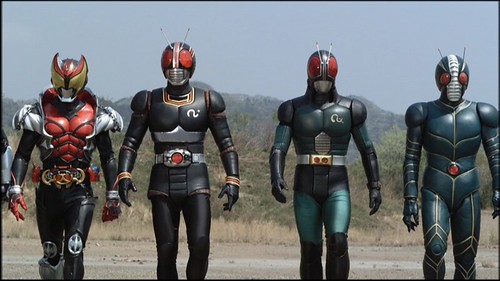

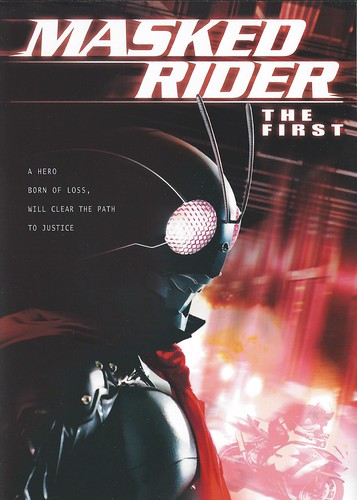

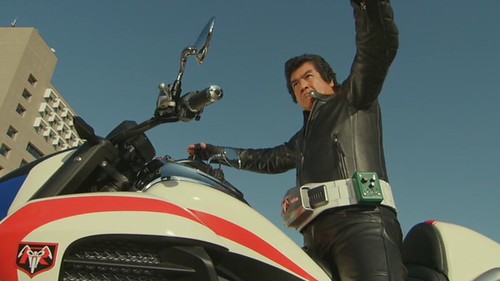
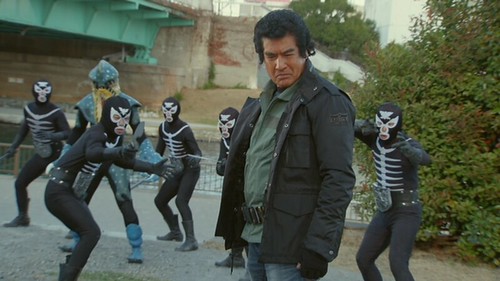


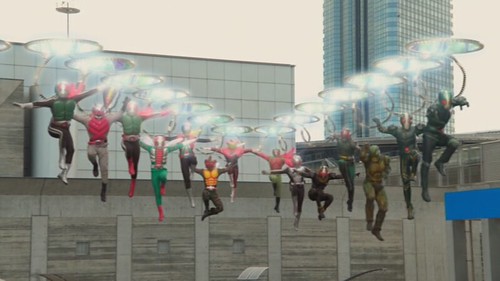
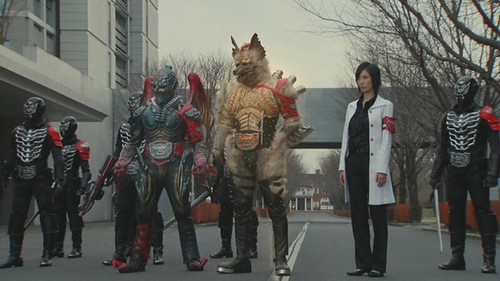

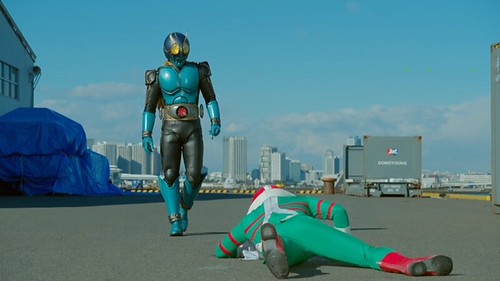
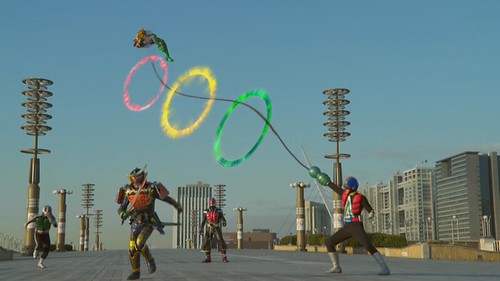
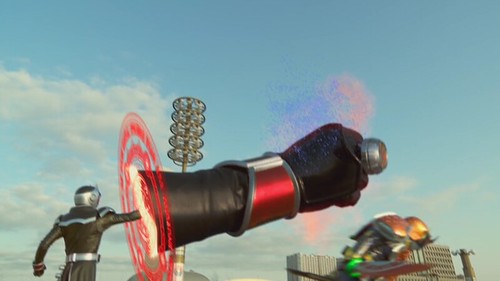

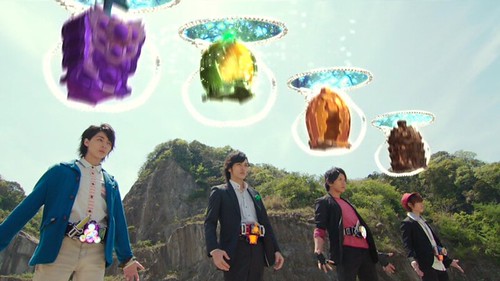
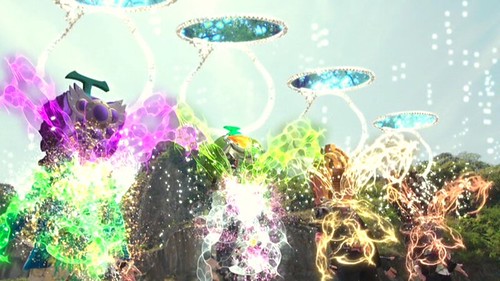
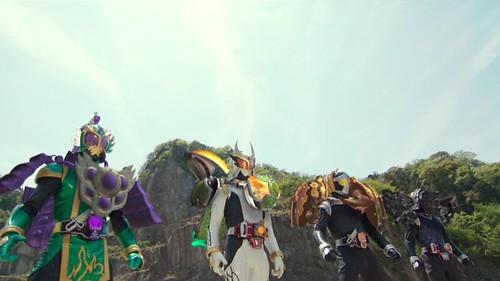

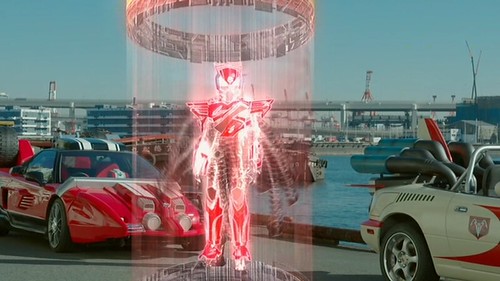
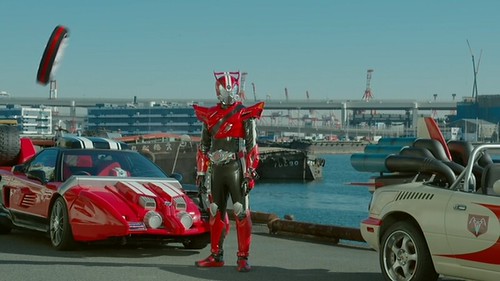



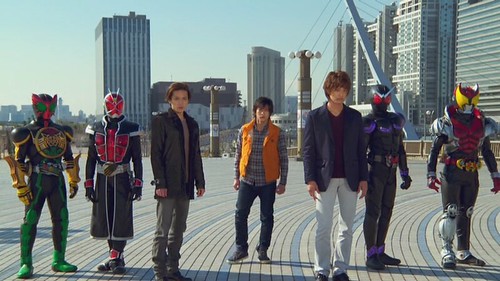
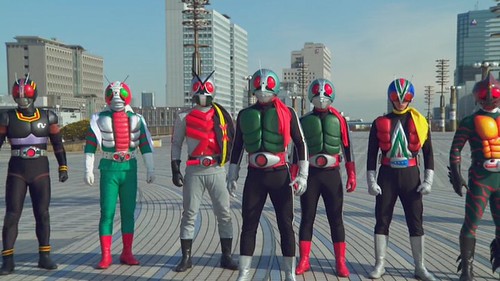
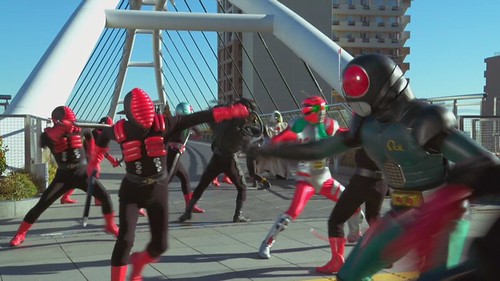



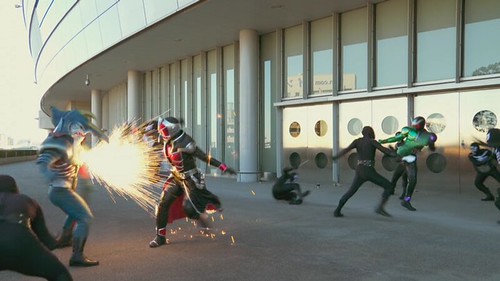
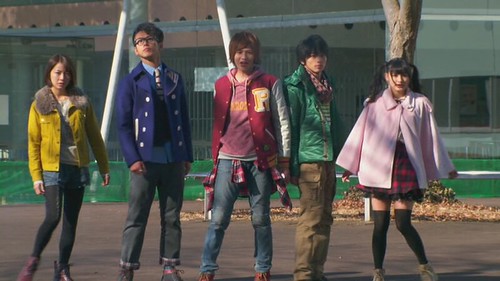
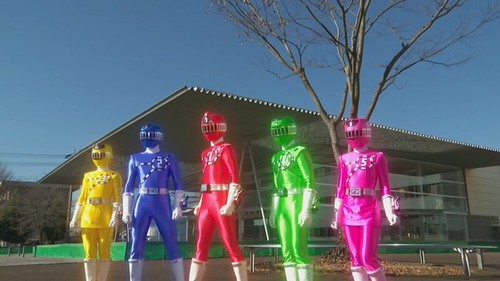
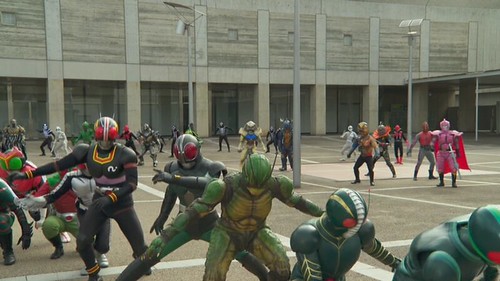
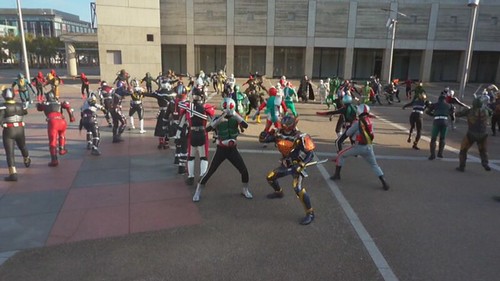



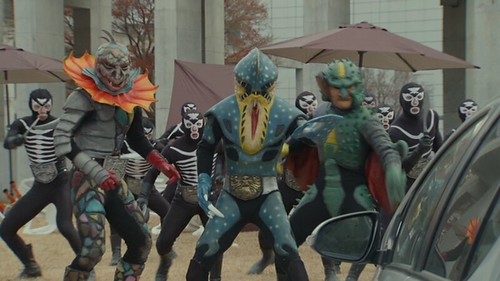
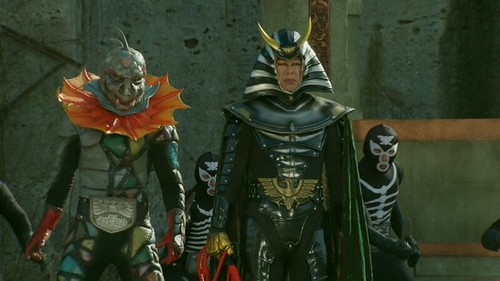
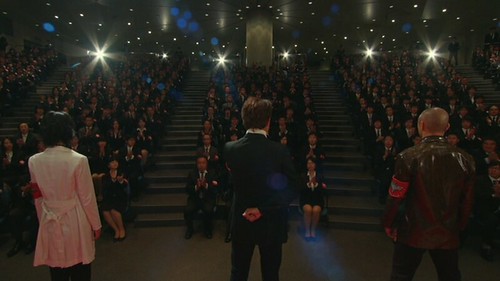


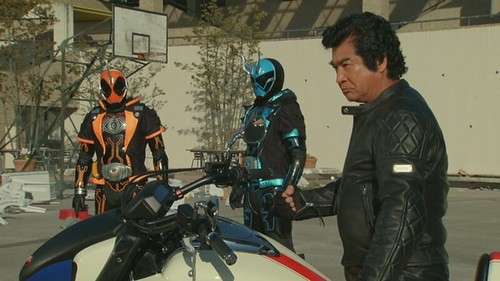

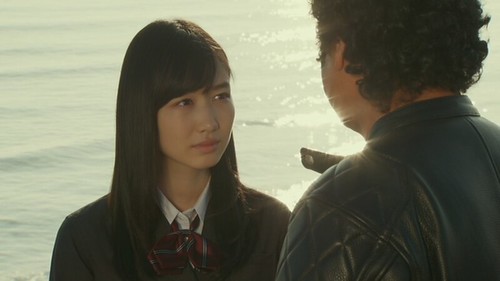
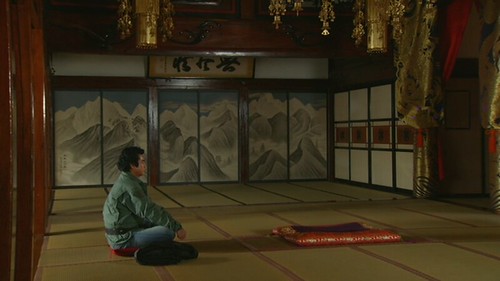

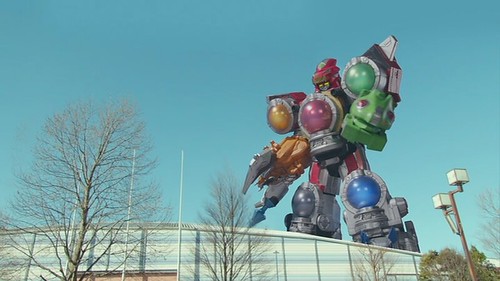
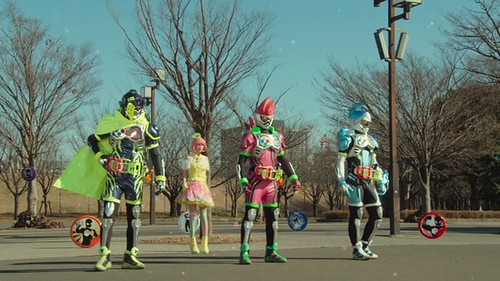


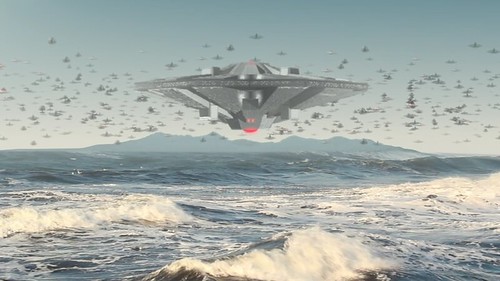
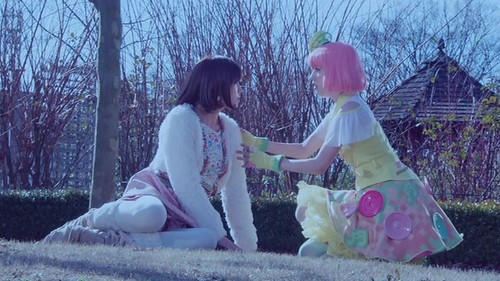
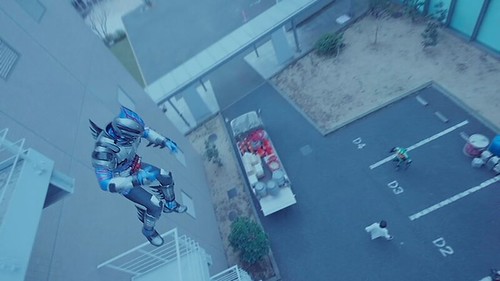
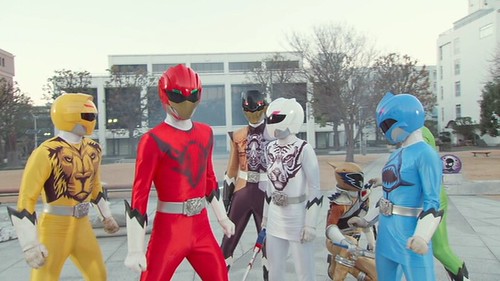


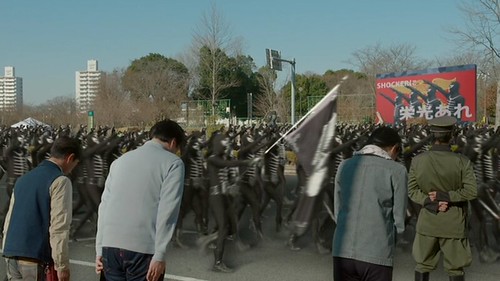
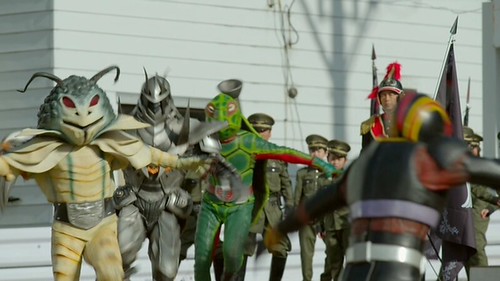
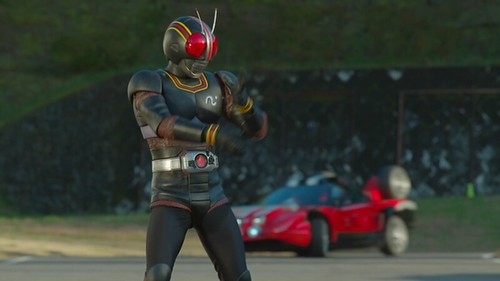


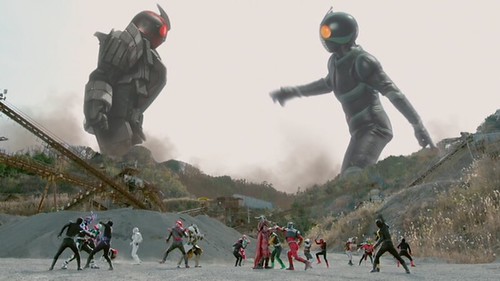
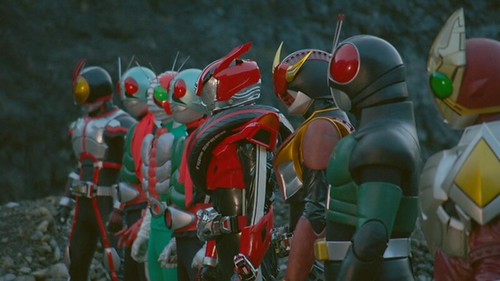

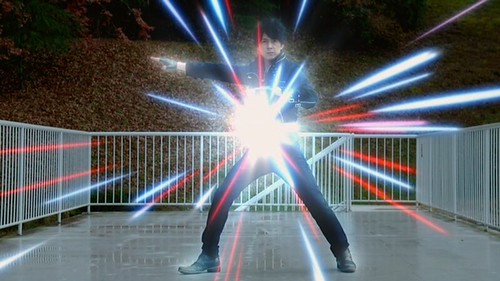


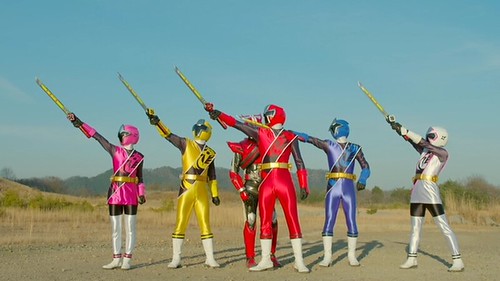
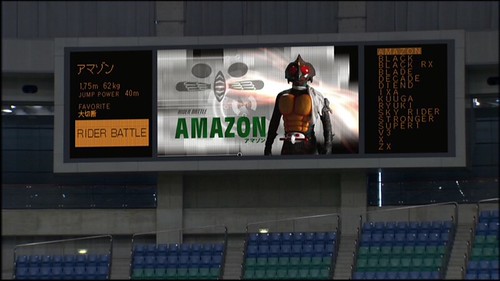
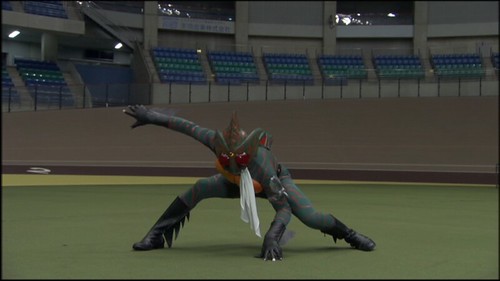

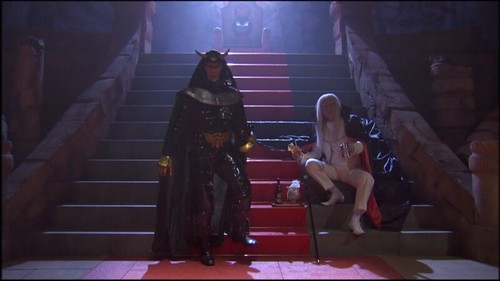
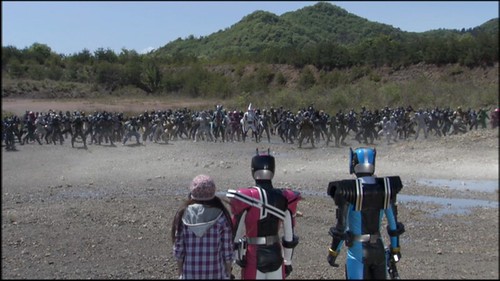
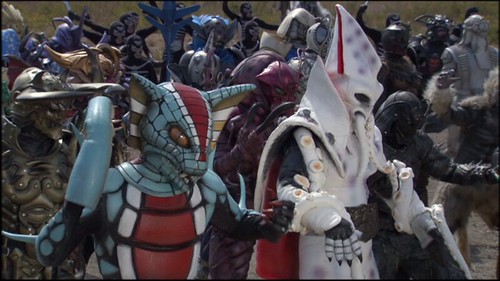
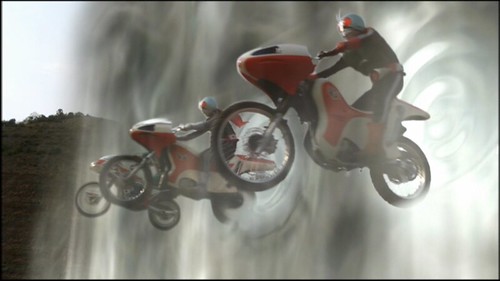


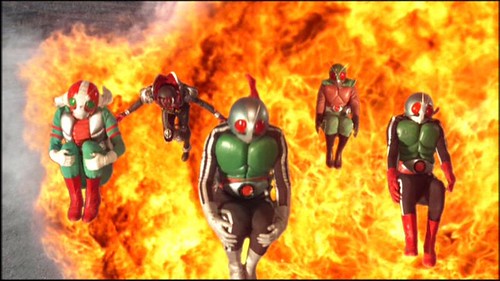


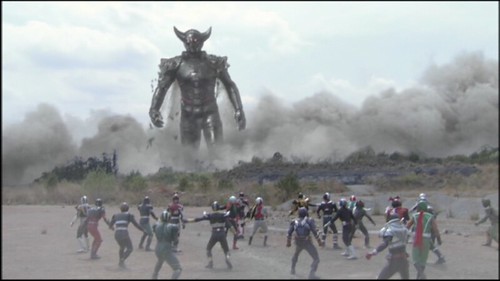

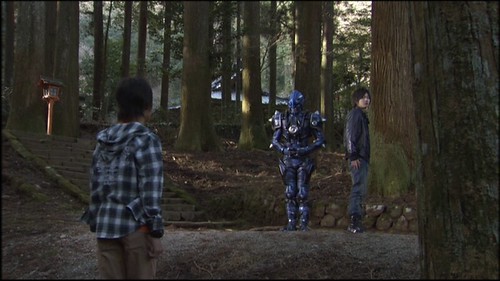
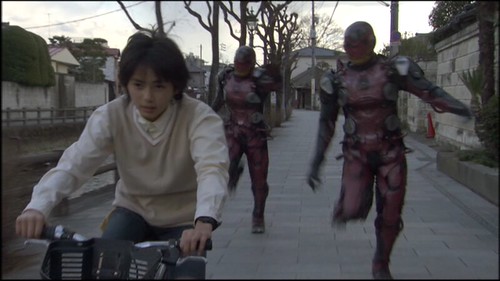
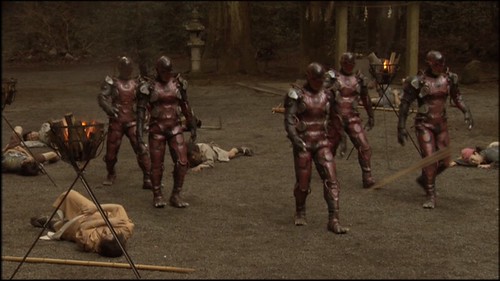

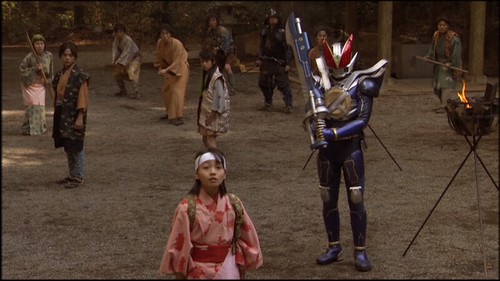

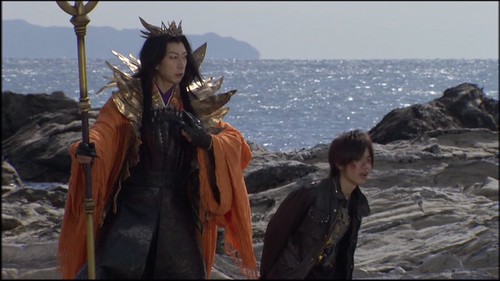
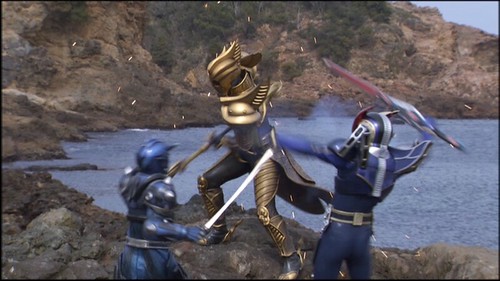


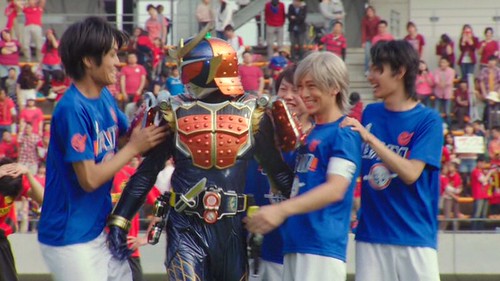
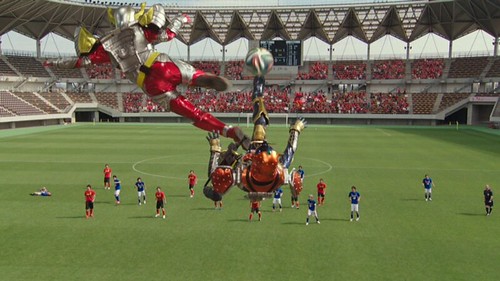


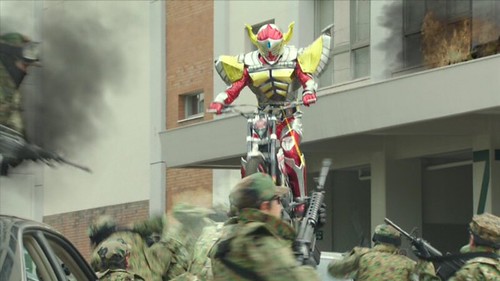
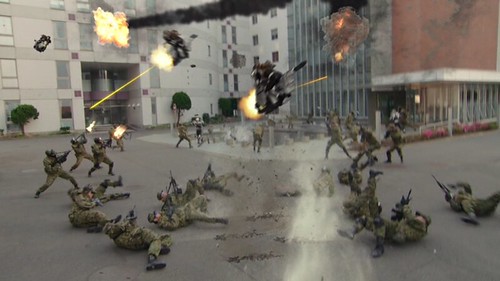




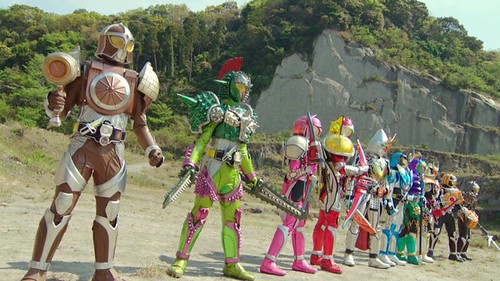


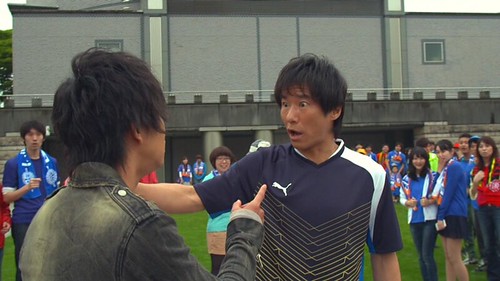
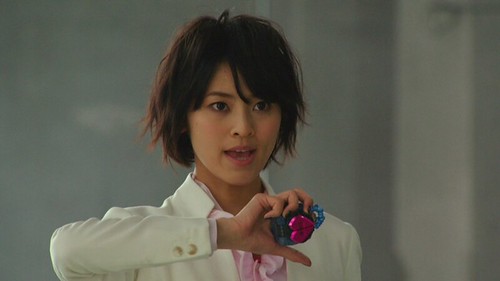


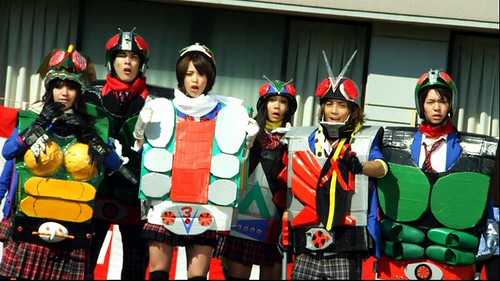
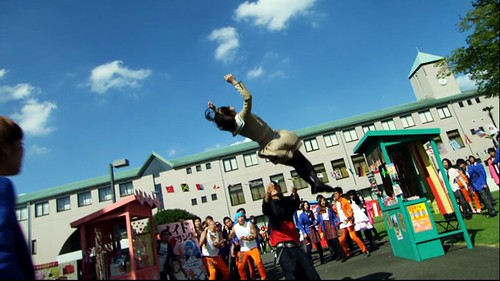

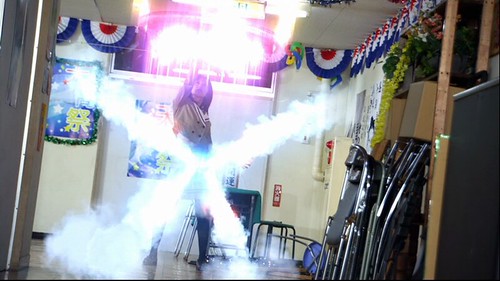
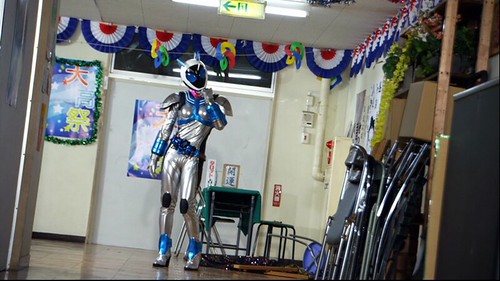




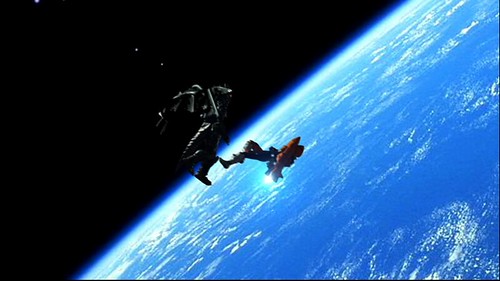
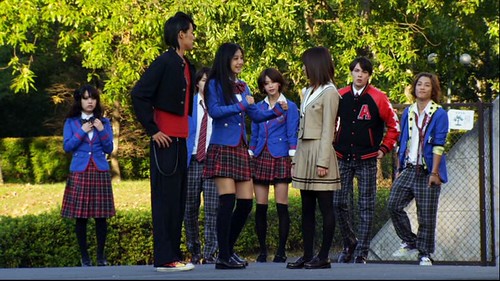
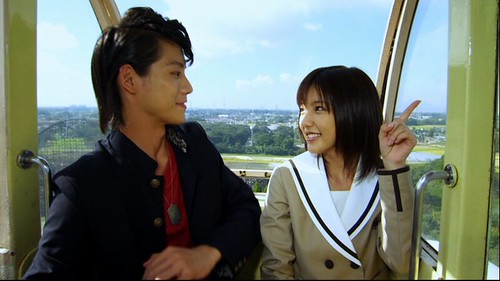






Leave a comment